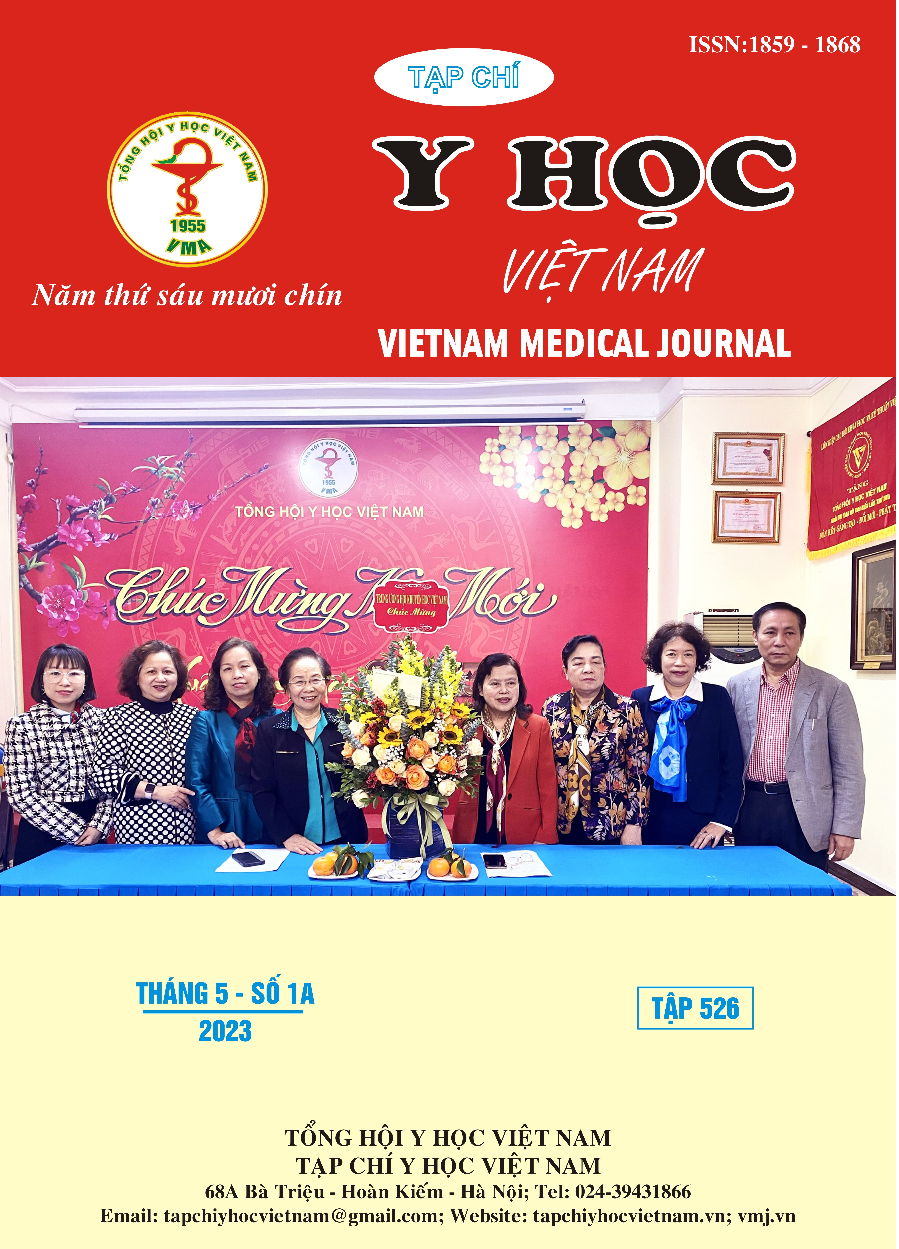ASSESSING OUTCOMES OF PERCUTANEOUS TRANSHEPATIC CHOLANGIOSCOPIC LITHOTRIPSY WITH LASER LITHOTRIPSY UNDER DIGITAL SUBTRACTION ANGIOGRAPHY GUIDANCE AT VIET DUC UNIVERSITY HOSPITAL
Main Article Content
Abstract
Objectives: Assessing outcomes of percutaneous transhepatic cholangioscopic with laser lithotripsy biliary under digital subtraction angiography guidance at Viet Duc University Hospital from march 2022 to august 2022. Subjects and methods: A prospective study of cases undergoing percutaneous transhepatic endoscopic lithotripsy under the guidance of ultrasound and digital subtration angiography at Viet Duc University Hospital from march 2022 to august 2022. Results: 50 patients met the inclusion criteria for the study, including 33 females (66%) and 17 males (34%), average age was 57.5 ± 16.8 years old (min 20 years old–max 93 years old). 41 patients (82%) had a history of biliary stones removal surgery, 25 patients had biliary stricture. Choledocholithiasis was observed in 16 patients (32%), 20 patients (40%) had intrahepatic and extrahepatic bile duct stones, the remaining patients had stones in the right and left intrahepatic bile ducts. The average size of gallstones in the liver was 21.4 ± 12.4mm (min 5mm – max 65mm) and common bile duct stone was 22.7 ± 15.1mm (min 4mm - max 82mm). The percutaneous transhepatic rigid cholangioscopic lithotripsy procedure with the appropriate ratio of portals for each patient of 14Fr (12.3%), 16Fr (14.0%), 18Fr (73.7%) increased the stone clearance rate after the procedure with the average stone clearance rate for intra- and extrahepatic stones (97.8 ± 6.1%), the rate of stone clearance in the common bile duct was 100% and the rate of intrahepatic stone clearance was 96.7 ± 7.1% , low lithotripsy time (46.6 ± 28.8 minutes), short hospitalization (5.9 ± 3.7 days) and low complication rate (7/50 patients accounted for 14%). Moderate - mild complications related to the procedure: 5 patients had a small right pleural effusion; 1 patient with transient fever after the procedure was treated with antibiotics and stabilized after 3 days; 1 patient with hemobilia was stable medically. Conclusion: The Percutaneous transhepatic cholangioscopic lithotripsy technique by laser under the guidance digital subtration angiography and ultrasound is a safe and effective technique in the treatment of biliary stone.
Article Details
Keywords
Percutaneous cholangioscopic lithotripsy by laser, biliary stone.
References
2. Lee JH, Kim HW, Kang DH, et al. Usefulness of Percutaneous Transhepatic Cholangioscopic Lithotomy for Removal of Difficult Common Bile Duct Stones. Clin Endosc. 2013;46(1):65-70. doi:10.5946/ce.2013.46.1.65
3. Galetti F, De Moura Dth, Ribeiro Ib, et al. Cholangioscopy-guided lithotripsy vs. conventional therapy for complex bile duct stones: a systematic review and meta-analysis. Arq Bras Cir Dig ABCD. 33(1):e1491. doi:10.1590/0102-672020190001e1491
4. Wang P, Chen X, Sun B, Liu Y. Application of combined rigid choledochoscope and accurate positioning method in the adjuvant treatment of bile duct stones. Int J Clin Exp Med. 2015; 8(9):16550-16556.
5. Jeong EJ, Kang DH, Kim DU, et al. Percutaneous transhepatic choledochoscopic lithotomy as a rescue therapy for removal of bile duct stones in Billroth II gastrectomy patients who are difficult to perform ERCP. Eur J Gastroenterol Hepatol. 2009;21(12):1358-1362. doi:10.1097/MEG.0b013e328326caa1
6. Lamanna A, Maingard J, Tai J, Ranatunga D, Goodwin M. Percutaneous transhepatic Laser lithotripsy for intrahepatic cholelithiasis. Diagn Interv Imaging. 2019;100(12):793-800. doi:10.1016/j.diii.2019.05.007
7. Wang P, Sun B, Huang B, et al. Comparison Between Percutaneous Transhepatic Rigid Cholangioscopic Lithotripsy and Conventional Percutaneous Transhepatic Cholangioscopic Surgery for Hepatolithiasis Treatment. Surg Laparosc Endosc Percutan Tech. 2016;26(1):54-59. doi:10.1097/SLE.0000000000000222
8. Huang MH, Chen CH, Yang JC, et al. Long-term outcome of percutaneous transhepatic cholangioscopic lithotomy for hepatolithiasis. Am J Gastroenterol. 2003;98(12):2655-2662. doi:10.1111/j.1572-0241.2003.08770.x


